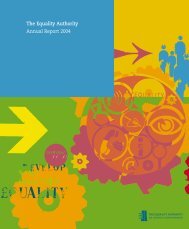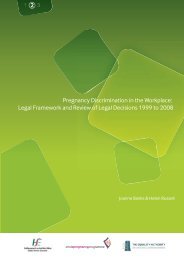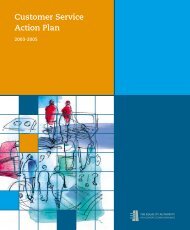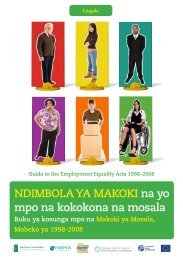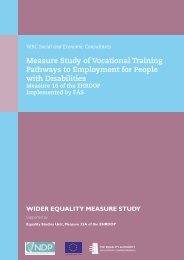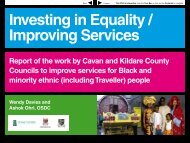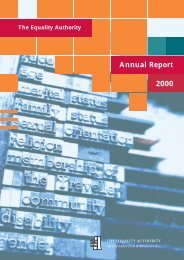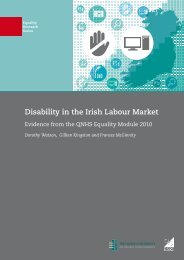Equality and Diversity - Building a Culture of ... - Equality Authority
Equality and Diversity - Building a Culture of ... - Equality Authority
Equality and Diversity - Building a Culture of ... - Equality Authority
Create successful ePaper yourself
Turn your PDF publications into a flip-book with our unique Google optimized e-Paper software.
Who has the power to decide what supports<br />
<strong>and</strong> resources can be made available?<br />
groups <strong>of</strong> people, for example, crosscommunity<br />
<strong>and</strong> cross-cultural relationships?<br />
<strong>Equality</strong> is about relationship:<br />
Does everyone have access to making a<br />
diverse range <strong>of</strong> friends?<br />
Is care work valued <strong>and</strong> respected in the<br />
community <strong>and</strong> in society?<br />
Is diversity explicitly recognised <strong>and</strong> named<br />
in school anti-bullying policies?<br />
Do schools <strong>and</strong> communities promote <strong>and</strong><br />
support good relations between diverse<br />
Note<br />
The equality/anti-discrimination legislation in<br />
Irel<strong>and</strong> <strong>and</strong> Northern Irel<strong>and</strong> does not cover<br />
every equality issue or theme. The legislation<br />
is very specific about the individuals <strong>and</strong><br />
groups protected under the law. It also has a<br />
very specific definition <strong>of</strong> discrimination <strong>and</strong><br />
it focuses on discrimination in the areas <strong>of</strong><br />
employment, <strong>and</strong>/or goods <strong>and</strong> services. (See<br />
Part 4 <strong>Equality</strong> <strong>and</strong> the Law for details).<br />
Teaching Controversial Issues<br />
– a Note for Teachers<br />
Teaching about equality <strong>and</strong> diversity<br />
can potentially raise issues that may<br />
be contentious or controversial. The<br />
methodologies used throughout the resource<br />
are designed to minimise the risks associated<br />
with teaching controversial issues in a<br />
classroom setting <strong>and</strong> to enable the issues<br />
to be discussed in a way that is safe <strong>and</strong><br />
respectful <strong>of</strong> others. You may find it helpful to<br />
incorporate the approaches below.<br />
Creating a Conducive Climate – Class<br />
Agreement or Ground Rules<br />
It is normal practice in citizenship education<br />
to spend time at the beginning <strong>of</strong> each year in<br />
developing a class agreement or set <strong>of</strong> ground<br />
rules which will underpin relationships <strong>and</strong><br />
behaviour in the classroom. Before commencing<br />
this module, it is strongly advised that the<br />
students review their agreement - in relation<br />
to the underlying core values they espouse, as<br />
well as the behaviours they expect <strong>of</strong> each other.<br />
They should preferably reflect on how these core<br />
values are implemented - for example, spend<br />
some time unpacking what respect for the rights<br />
<strong>of</strong> others really means <strong>and</strong> what it would look<br />
like in practice in small group work, discussion<br />
<strong>of</strong> any kind, <strong>and</strong> other situations.<br />
Encouraging critical thinking <strong>and</strong> the<br />
inclusion <strong>of</strong> a range <strong>of</strong> perspectives<br />
It is recommended that, before you start, you<br />
think through the positions or stances you<br />
will take as you work through the module <strong>and</strong><br />
decide which position is the more appropriate<br />
for you to take in any particular lesson:<br />
be a neutral facilitator<br />
declare where you st<strong>and</strong> on an issue<br />
play devil’s advocate to provide a wider<br />
perspective when the whole class is in<br />
agreement<br />
support a minority viewpoint among the<br />
students to ensure the majority seriously<br />
consider all aspects <strong>of</strong> an issue. You will find<br />
that all <strong>of</strong> these positions are appropriate<br />
or inappropriate at different times. When<br />
in doubt, returning to your basic aims in<br />
teaching the topic <strong>and</strong> to the fundamental<br />
basis <strong>of</strong> human rights will help you decide.<br />
Using Safe Methodologies<br />
Pairs <strong>and</strong> small groups provide a safe<br />
environment for students to engage fully with<br />
discussion questions without having to publicly<br />
state their position. Questions which are framed<br />
within the context <strong>of</strong> what human rights or<br />
the law says about an issue makes it safer for<br />
students by depersonalising the discussion.<br />
Asking what the government, the community,<br />
the school, or an individual could do in response<br />
to, for example, racism or homophobia, is a<br />
much safer way to discuss these issues than<br />
asking students ‘What would you do if...?<br />
For further reading on approaches, frameworks<br />
<strong>and</strong> methodologies, see Tackling Controversial<br />
Issues in the Classroom. A Resource for Citizenship<br />
Education (2012) published by the CDVEC<br />
Curriculum Development Unit. It is available<br />
from the CDU (address on back cover) or on-line<br />
at www.reconciliation.ie<br />
8 Introduction




